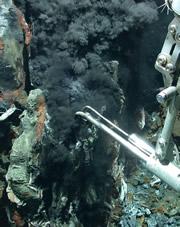 A probe delves into water so hot it is nearly vapour.© MARUM, University of Bremen
A probe delves into water so hot it is nearly vapour.© MARUM, University of BremenScientists working in the southern Atlantic Ocean have found a 407 °C hydrothermal vent, the hottest yet known on an ocean floor. Although only 5 °C hotter than the previous deep-sea high of 402 °C, recorded in the Pacific Ocean, the new hotspot bumps seawater into the strange state of being a supercritical fluid.
Expedition leader Andrea Koschinsky of International University in Bremen, Germany, and her team found the hydrothermal vent, also known as a black smoker, just south of the Equator on the Mid-Atlantic Ridge at a depth of 2,990 metres — or 299 bar pressure. At pressures and temperatures above 298 bar and 407 °C, seawater becomes something between a thin liquid and a dense vapour: a supercritical fluid.
Such fluids can diffuse through solids a bit like a gas and dissolve materials more like a liquid. In industrial applications, supercritical carbon dioxide and water are used as solvents thanks to these unusual properties. On the ocean floor, supercritical seawater could dissolve and transport minerals from the surrounding rocks differently than at other hot vents.
Weird water
The vent was first discovered in March 2005, but it was only this May that Koschinsky and her team were able to position a sensor deep inside the black smoker and take its true temperature. Samples of pure supercritical fluid also were collected.
A complete chemical analysis of the supercritical fluid won't be possible until the expedition ends in early June and the team returns to land-based laboratories, Koschinsky says. But it is already clear that the water is quite different from that at other vents.
"This vent has some very strange chemistry," says Koschinsky. It has very little if any free hydrogen sulphide, for example, which has been found in high concentrations in all other vent samples. "Possibly the sulphide in these fluids is present in a different chemical form," she says. That could have implications for how life might survive in the strange environment.
Slow burn
The vent is located on the Mid-Atlantic Ridge, where the African and the South American continental plates are moving apart at the relatively sedate rate of 3.2 cm a year. In the Pacific, by comparison, the Pacific and Nazca plates are speeding apart at some 15 cm per year.
ADVERTISEMENT
The accepted wisdom has been that faster plate movement leads to more volcanic activity at the spreading site, says Colin Devey, a member of the team and a geologist at Leibniz Institute of Marine Sciences in Kiel, Germany. "If you were to ask almost any petrologist where they would go looking for active volcanism and voluminous eruptions in the ocean basins, they almost certainly would not say the Atlantic," he says.
The discovery of this hotspot will change people's thinking, he says. "The accepted wisdom is wrong."
Visit our hotspotfound_underwate.html">newsblog to read and post comments about this story.
